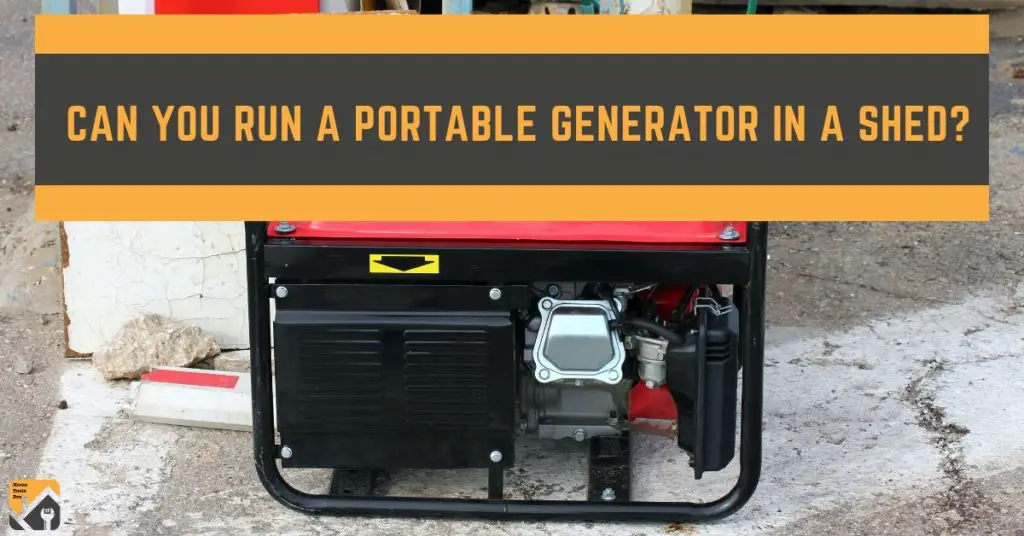A generator can be a lifesaver during a power outage. But, if used improperly, it can also be a deadly hazard. Carbon monoxide (CO) poisoning is the leading cause of generator-related deaths, according to the Consumer Product Safety Commission (CPSC).
When placing your portable generator, most people wonder whether they can run it in a shed.
The truth is that running a portable generator in a shed is fine as long as it is properly ventilated. A fully covered shed will be too dangerous to run your generator.
In this article, we will look at the dangers of running a generator in an enclosed space and give you some tips on how to use your portable generator properly.
Portable Generator
A portable generator is a small, engine-powered unit that produces electrical power. Portable generators are useful in a variety of situations, including when utility power is unavailable or when extra power is needed for tools and equipment.
Most portable generators run on gasoline or diesel fuel, and they can be used to power everything from small appliances to large construction equipment. Portable generators come in a variety of sizes, and they can be purchased at most hardware and home improvement stores.
How to Place a Portable Generator Before Starting to Run it?
Before starting your portable generator, it is important to place it in the right location. Here are a few tips on where to put your generator and how to set it up for safe operation:
- Choose a level area that is well-ventilated and away from any buildings or other structures.
- Place the generator on a firm surface, such as a concrete pad or gravel bed, to prevent it from tipping over.
- If you are using the generator indoors, be sure to open all doors and windows for ventilation and use an extension cord rated for outdoor use to connect it to any appliances or devices.
- Be sure to read the manufacturer’s instructions on proper generator operation and safety before starting it up.
Follow these tips, and you’ll be sure to safely and effectively use your portable generator.
The Danger of Running a Portable Generator in a Covered Shed
If you’re using a portable generator, it’s important to be aware of the dangers of running it in a covered shed.
A generator can produce carbon monoxide, which is a colourless and odourless gas that can be deadly. When used in an enclosed space, a portable generator can quickly fill the area with carbon monoxide. This can lead to asphyxiation and death.
Running a portable generator in a covered shed is also a fire hazard. The generator’s engine produces heat, and if that heat isn’t properly ventilated, it can start a fire.
If you must use a portable generator, be sure to follow all safety precautions. Place the generator outside and away from any windows or doors. Keep it well ventilated, and never run it in an enclosed space. By following these simple safety tips, you can avoid a tragedy.
How Much Ventilation Does a Generator Need?
A generator needs ventilation to function properly and to avoid health hazards posed by exhaust fumes. The amount of ventilation required depends on the size and type of generator.
Small generators may need as little as 100 square inches (0.065 m2) of ventilation, while large generators may require 1,000 square inches (6.5 m2) or more. Ventilation should be increased if the generator is used in a hot or humid environment or if it is used to power high-demand appliances.
Proper ventilation is essential to the safe and efficient operation of a generator. Be sure to consult your owner’s manual for specific ventilation requirements for your model.
How to Safely Operate a Portable Generator?
If you’re like most people, you probably don’t give much thought to your portable generator until the power goes out. But if you take a few minutes to learn how to operate your generator safely, you can avoid some serious problems.
Here are a few tips on how to safely operate a portable generator:
- Read the manufacturer’s instructions carefully before using the generator.
- Never operate the generator inside your home or garage. Generators produce deadly carbon monoxide gas, so it’s important to keep them outside.
- Make sure the generator is properly grounded before operating it.
- Never refuel the generator while it’s running. Wait until it’s cool before adding fuel.
- Use heavy-duty, outdoor-rated extension cords to connect the generator to your appliances. Be sure to use the correct size cord for the appliance you’re connecting.
By following these simple tips, you can safely operate your portable generator and avoid some serious hazards.
How to Store a Portable Generator When It’s Not in Use?
If you have a portable generator, it’s important to know how to store it properly when it’s not in use. Here are some tips:
-
Keep the generator in a dry, ventilated area.
-
Make sure the generator is turned off and disconnected from any power source before storing it.
-
Store the generator in a cool, dark place.
-
Check the generator regularly to make sure it’s in good working condition.
Following these tips will help ensure that your portable generator is ready to use when you need it.
Where Should You Not Put a Portable Generator?
While these devices are incredibly versatile and can be used in a variety of different situations, there are still some things to keep in mind when it comes to their placement.
Here are a few places where you should avoid putting your portable generator:
-
Inside your home or garage
While it might seem like a good idea to put your generator inside your home or garage in order to keep it out of the elements, this is actually a very bad idea. Portable generators produce carbon monoxide gas as they operate, and this gas can build up to dangerous levels in enclosed spaces.
-
Near windows or air vents
You also want to avoid putting your portable generator near windows or air vents. The carbon monoxide gas produced by the generator can seep into your home through these openings, putting you and your family at risk.
-
In wet or damp areas
It’s important to keep your portable generator dry, so avoid putting it in wet or damp areas. If the generator does get wet, be sure to dry it off immediately to prevent any damage.
-
In an enclosed space
As we mentioned before, portable generators produce carbon monoxide gas. This gas can build up to dangerous levels in enclosed spaces, so it’s best to avoid putting your generator in one.
-
Underneath a tarp or cover
While you might be tempted to put your generator underneath a tarp or cover to protect it from the elements, this can actually be dangerous. The gas produced by the generator can become trapped under the tarp, creating a risk of carbon monoxide poisoning.
By following these simple guidelines, you can help ensure that your portable generator is used safely and effectively. Keep these tips in mind the next time you need to use your generator, and you’ll be sure to stay safe.
Frequently Asked Questions Related to Placing Your Portable Generator
-
Can I run a generator in a shed with the door open?
Yes, you can run a generator in a shed with the door open as long as there is plenty of ventilation.
If you’re running a generator in your shed, you want to make sure that there is plenty of ventilation to keep both the generator and the shed itself cool.
Running a generator with the door open will help to ensure that there is enough airflow, but it’s also important to make sure that there is no combustible material near the generator.
-
Can I cover my generator while it’s running?
You can certainly cover your generator while it’s running, but there are a few things to keep in mind.
First, be sure that even if you have covered the unit, it is still ventilated. Without proper ventilation, your generator can overheat and pose a fire hazard.
Second, don’t put the cover too close to the generator itself – you want to leave enough space for air to circulate around the machine.
Finally, make sure that any cords or power lines passing through the cover are properly insulated, so they don’t pose an electrocution risk.
By following these simple precautions, you can safely and efficiently use your covered generator.
-
Can you run a generator in a closed garage?
You can, but it’s not recommended. Generators produce carbon monoxide, which can build up and become dangerous in a closed space.
Running a generator in an open garage is fine, as long as you’re careful to keep the exhaust away from any doors or windows that could allow the CO to seep into your home.


